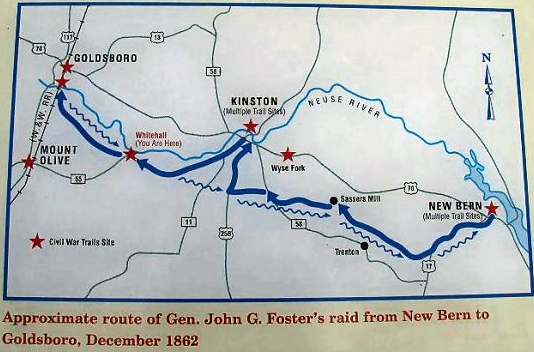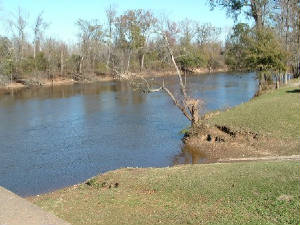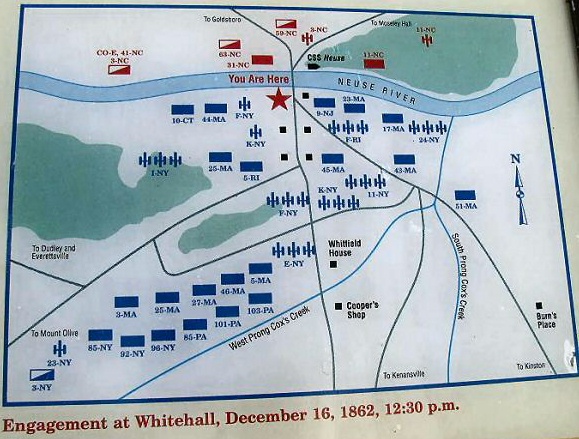|
High Casualties Force Yankee Withdrawal From White Hall
| Civil War Battle of Whitehall, NC |

|
| White Hall Bridge, North Carolina |
Battle of White Hall (AKA Whitehall and White Hall Ferry)
On December 15-16, 1862, on a raid at Whitehall, Union troops led by Gen.
J. G. Foster damaged the Confederate Ram "Neuse."
Although the Yankees slightly damaged the CSS Neuse and destroyed a
large portion of White Hall, they suffered nearly 150 casualties, were forced to withdrawal, and then regrouped at Goldsboro.
Confederate losses were reported as “few.”
The engagement between Federal and Confederate forces at Whitehall (today
known as Seven Springs) took place during Union General J. F. Foster’s raid from New Bern to Goldsboro in late 1862.
On December 15, Foster’s contingent of three companies of cavalry and several pieces of artillery entered Whitehall,
which is located on the south bank of the Neuse River several miles above Kinston, hoping to capture or destroy the railroad
bridge and confirm suspicions of Confederate ironclad construction on the river. Upon their arrival, they found the bridge
burned by the Confederates in order to protect the ironclad and the opposite bank of the river occupied by several regiments
of Confederate troops under the command of Brigadier General B. H. Robertson. During the ensuing battle, which lasted through
December 16, the Federal artillery bombarded Confederate positions with such a barrage that the dense woods along the bank
were cut down for a quarter of a mile back from the river and construction materials for the ironclad were damaged or destroyed.
| Map of the Route to Goldsboro: Civil War History |

|
| Goldsboro Expedition (Foster's Raid) Eastern North Carolina |
While Union and Confederate Forces occupied opposite sides of the river, a fierce artillery duel ensued.
| Neuse River (present-day) |

|
| (Civil War Battlefield) |
After the Confederates had burned the Neuse River Bridge (aka White Hall
Bridge), they assumed position on the North side of the river. While the Union forces occupied a hill on the South side of
the river, the two sides exchanged devastating artillery fire.
Federal reinforcements arrived the next day and Foster placed them in exposed
locations along the river bank, resulting in heavy casualties. Confederate casualties were low since geographical restrictions
on the river at the site of the conflict allowed only one regiment at a time to engage the Federals. In addition to damaging
the town and its river fortifications, the Confederate ironclad ram, the CSS Neuse, under construction on the north bank of
the river, was damaged during the raid. Eager to move toward Goldsboro about eighteen miles distant, Foster withdrew his forces
from Whitehall during the evening of the sixteenth, confident that the bridge and ironclad were destroyed.
| Union and Confederate Army Positions at White Hall |

|
| Battle of Whitehall Map of the Union and Confederate Armies |
However, damage to the Neuse was minimal and work resumed on the ironclad
after Foster’s withdrawal. Local citizens were left with the tasks of cleaning up, burial of the dead in mass graves,
and providing care for the wounded. In recent years questions have arisen about the Whitehall battle, with speculation that
many of the Union casualties were the result of friendly fire and that body counts were purposefully under-reported by the
federal government.
References: John G. Barrett, The Civil War in North Carolina (1963); CSS Neuse State Historic
Site; W. W. Howe, Kinston, Whitehall, and Goldsboro Expedition: December 1862 (1890); L. G. Williams, A Place for Theodore
(1997); Goldsboro News Argus, December 6, 1993; (Raleigh) News and Observer, October 22, 1991; NC Office of Archives and History.
Recommended Reading: The Civil War in North Carolina.
Description: Numerous battles and skirmishes were fought in North Carolina during the Civil War, and the campaigns and battles
themselves were crucial in the grand strategy of the conflict and involved some of the most famous generals of the war. John
Barrett presents the complete story of military engagements across the state, including the classical pitched battle of Bentonville--involving
Generals Joe Johnston and William Sherman--the siege of Fort
Fisher, the amphibious campaigns on the coast, and cavalry sweeps such
as General George Stoneman's Raid.
Recommended Reading: Iron Afloat:
The Story of the Confederate Armorclads.
Description: William N. Still's book is rightfully referred to as the standard of Confederate Naval history. Accurate and
objective accounts of the major and even minor engagements with Union forces are combined with extensive background information.
This edition has an enlarged section of historical drawings and sketches. Mr. Still explains the political background that
gave rise to the Confederate Ironclad program and his research is impeccable. An exhaustive literature listing rounds out
this excellent book. While strictly scientific, the inclusion of historical eyewitness accounts and the always fluent style
make this book a joy to read. This book is a great starting point.
Recommended
Reading: The Civil War in the Carolinas (Hardcover). Description: Dan Morrill relates the
experience of two quite different states bound together in the defense of the Confederacy, using letters, diaries, memoirs,
and reports. He shows how the innovative operations of the Union army and navy
along the coast and in the bays and rivers of the Carolinas affected the general course of
the war as well as the daily lives of all Carolinians. He demonstrates the "total war" for North Carolina's vital coastal railroads and ports. In the latter
part of the war, he describes how Sherman's operation cut
out the heart of the last stronghold of the South. Continued below...
The author
offers fascinating sketches of major and minor personalities, including the new president and state governors, Generals Lee,
Beauregard, Pickett, Sherman, D.H. Hill, and Joseph E. Johnston. Rebels and abolitionists, pacifists and unionists, slaves
and freed men and women, all influential, all placed in their context with clear-eyed precision. If he were wielding a needle
instead of a pen, his tapestry would offer us a complete picture of a people at war. Midwest Book Review: The Civil War in the Carolinas by civil war expert and historian Dan
Morrill (History Department, University of North Carolina at Charlotte, and Director of the Charlotte-Mecklenburg Historical
Society) is a dramatically presented and extensively researched survey and analysis of the impact the American Civil War had
upon the states of North Carolina and South Carolina, and the people who called these states their home. A meticulous, scholarly,
and thoroughly engaging examination of the details of history and the sweeping change that the war wrought for everyone, The
Civil War In The Carolinas is a welcome and informative addition to American Civil War Studies reference collections.
Recommended
Reading: Ironclads and Columbiads:
The Coast (The Civil War in North Carolina)
(456 pages). Description: Ironclads
and Columbiads covers some of the most important battles and campaigns in the state. In January 1862, Union forces
began in earnest to occupy crucial points on the North Carolina
coast. Within six months, Union army and naval forces effectively controlled coastal North Carolina
from the Virginia line south to present-day Morehead
City. Union setbacks in Virginia, however, led to the withdrawal of many
federal soldiers from North Carolina, leaving only enough Union troops to hold a few coastal strongholds—the vital ports
and railroad junctions. The South during the Civil War, moreover, hotly contested the North’s ability to maintain its
grip on these key coastal strongholds.
Recommended
Reading: Storm over Carolina: The Confederate Navy's Struggle for Eastern
North Carolina. Description: The struggle for control of the eastern waters of North
Carolina during the War Between the States was a bitter, painful, and sometimes humiliating one for
the Confederate navy. No better example exists of the classic adage, "Too little, too late." Burdened by the lack of
adequate warships, construction facilities, and even ammunition, the South's naval arm fought bravely and even recklessly
to stem the tide of the Federal invasion of North Carolina from the raging Atlantic.
Storm Over Carolina is the account of the Southern navy's struggle in North Carolina waters and it is a saga of crushing defeats interspersed
with moments of brilliant and even spectacular victories. It is also the story of dogged Southern determination and incredible
perseverance in the face of overwhelming odds. Continued below...
For most of
the Civil War, the navigable portions of the Roanoke, Tar, Neuse, Chowan, and Pasquotank rivers were
occupied by Federal forces. The Albemarle and Pamlico sounds, as well as most of the coastal towns and counties, were also
under Union control. With the building of the river ironclads, the Confederate navy at last could strike a telling blow against
the invaders, but they were slowly overtaken by events elsewhere. With the war grinding to a close, the last Confederate vessel
in North Carolina waters was destroyed. William T. Sherman
was approaching from the south, Wilmington was lost, and the
Confederacy reeled as if from a mortal blow. For the Confederate navy, and even more so for the besieged citizens of eastern
North Carolina, these were stormy days indeed. Storm Over Carolina describes their story, their struggle, their history.
Recommended
Reading: The
Civil War on the Outer Banks: A History of the Late Rebellion Along the Coast of North Carolina from Carteret to Currituck
With Comments on Prewar Conditions and an Account of (Hardcover: 243 pages). Description: The ports at Beaufort, Wilmington, New Bern and Ocracoke, part of the Outer Banks (a chain of barrier islands that
sweeps down the North Carolina coast from the Virginia Capes to Oregon Inlet), were strategically vital for the import
of war materiel and the export of cash producing crops. From official records, contemporary newspaper accounts, personal journals
of the soldiers, and many unpublished manuscripts and memoirs, this is a full
accounting of the Civil War along the North Carolina coast.
|

